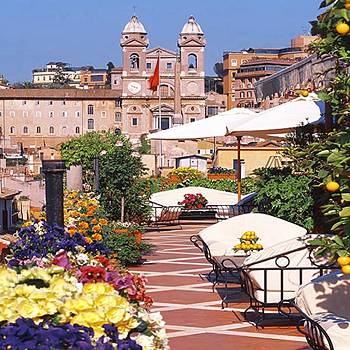

 Sherif Sonbol
Sherif SonbolBy: Hoda Nassef
Whenever I go to the Cairo Opera House to watch a ballet performance, I always notice a quite man sitting in one of the choice chairs, carrying an assortment of cameras, with the lens pointing at the stage. While photographing, he would slink down in his chair to avoid obstructing the view from other spectators, and somehow manage to photograph the ballet performers. Amazingly, each photo would turn out to be a work of art, resembling live paintings on canvas. Intrigued, one day I asked my sister, whose daughter is a ballet soloist, “Who’s that man?” She answered, “Sherif Sonbol, of course!”
Sherif Sonbol and I met just a day after his arrival from America, where he was invited to make an exhibition at the New York Public Library for Performing Arts at the Lincoln Center in New York City. It coincided with the September 11th second anniversary, so it must have been very significant for an Egyptian to be invited during that time.
The first impression you get when you talk to Sherif Sonbol is his gentle manner and politeness, dispelling the myth that most photographers or journalists are nosy, rude and aggressive, at best. His modesty and humility was the next thing that struck me. And, he is extremely sensitive and self-effacing, with slow body movements, but very confident and outspoken, in what he knows best: photography. The third thing that was obvious from the outcome of our conversation, is his candidness and willingness to share his genius in photography by giving credit – either deserved or not – to all people whom he claims helped or influenced his successful career.
Sherif Sonbol was born in Cairo on 6 December 1956, and graduated from the Faculty of Commerce in Cairo, Insurance Department. He freelanced as a photographer, and then started his career as an employee in one of the insurance companies in Cairo. Afterwards, he completed his high studies from the world-renowned Chartered Insurance Institute of London. Harboring a secret dream, after eight years he left the company to pursue his goal in photography as a career.
However, he wanted to back up his hobby with academic studies, and tried to enroll in the Faculty of Applied Arts. That was the first wall he encountered, blocking his path to his dreams. The faculty refused to let Sonbol enroll in night classes, because, as they told him, he already had a university degree in commerce.
Paradoxically, they offered him instead a teaching job at the faculty! Sonbol declined. Not being daunted by this first obstacle, Sonbol persevered and made his first independent photography exhibition two years later, at the new Cairo Opera House, where many high caliber VIPs attended. Coincidentally, during the same exhibition, he was approached by the dean of the photography section of the Faculty of Applied Arts, who then complimented him on his work, and offered him a teaching position at the institute.
The same rationale followed. According to Sonbol, who was once more exasperated, he found it ridiculous that his request to enroll as a student was once more rejected, because of his former degree, yet they wanted him as a teacher! And, once again, he declined the teaching offer.
Since he was already successful as a photographer, why did he insist on enrolling? “Because we don’t have a real photography critique, backed by academic studies. Whenever anyone comments on the pictures, they say it’s nice, or not nice – never giving their reason or details of their opinions. No one is yet a professional critic in photography. And, I wanted to learn!”
Nevertheless, talented and self-taught, he gradually had his work published in several books. His earlier work consisted of the “moulid”, (the Egyptian ‘Mardi gras’) at a time when renowned photographer Antoun Albert was the director of photography at a daily newspaper. Sonbol’s first assignment for the newspaper was to cover the ‘moulid’. When he developed the film, Albert admonished him and told him that they would not do. He then explained to Sonbol that in a “moulid”, one doesn’t use a flash.
Going back again the next day, Sonbol painstakingly photographed everything again, using a completely different technique without a flash. Antoun Albert was Sonbol’s ‘first school of learning,” as well as his idol. Much later, Sonbol covered many “mulids” all over Egypt, not for the newspaper, but for himself, and had his work published by the AUC press.
Almost equaling his passion for photography is his love for ballet. Typical of his perseverance in reaching his goals as a skilled photographer, it is no wonder that he is knowledgeable in every minute detail of ballet choreography; capturing precise movements at the exact precise time on camera – giving each breathtaking picture a timeless frame of beauty and infinity.
His first attempt at photographing a ballet performance was in the mid-seventies. One day he took his camera to a ‘prova’ (rehearsal) of the ballet performance, sat in the ‘baignoire’ at the Gomhouria Theater (before the new Opera House was constructed), and happily clicked away. But, that didn’t last long, because suddenly there was a group of security personnel who barged into the baignoire, and requested him to stop immediately.
Apparently he was distracting the dancers, and had to take the permission from the ballet director “Mike” (Dr. Abdel Moneim Kamel). Leaving unabashed, he developed his film, and returned the next day to show “Mike” the pictures. Reminiscing, Sonbol added, “He said they were ‘nice’, but I felt that he said that only out of politeness. I also met Mrs. Erminia, his wife, who was also the ballet troupe’s Prima Dona (first dancer), and she volunteered to teach me how to be a ballet photographer, reasoning that the Opera Ballet Troupe also needed a photographer of ballet.
That meant that I had to go through every single ballet step and movement and learn and anticipate the exact body movements and pause of each dancer in each dance. It was very crucial that I take the shots without distracting the dancers while at the same time photograph the best movements and poses. The secret is to photograph each movement when it is complete, and not a second too soon, or a second too late.”
With Ms. Erminia’s infinite patience throughout several days, he finally had his first real lessons in photography, and discovered that he wanted to specialize in ballet photography. Erminia Kamel was his ‘second school of learning.’ Five years later, to celebrate the fifth anniversary after inaugurating the new Cairo Opera House, Sonbol’s first book, simply named “The Opera”, was published.
Apart from ballet photography, it is not well known to everyone that he is also an expert at photographing monuments, pharaohs, and architectural structures. His ‘third school of learning’ came through yet another woman, when Eva Schubert, head of the project called “muséums sans frontiers” (MSF) or ‘museums without frontiers’ came to Egypt six years ago, and asked the Minstry of Culture to provide her with ‘antiquities people’ and expert photographers to document Egypt’s museums for the project. Sonbol was selected.
“It was something totally new for me; I would photograph high buildings, using fish-eye lenses, and the structures would become circular, and I thought I invented a unique technique,” he said, smilingly, “And so I smugly sent the pictures to the publisher in Spain. To my surprise, they were rejected! I was informed that the walls of any structure should be angular and appear as natural as possible. So, after several attempts and techniques of modifying these mistakes, they were finally accepted.”
His ‘fourth school of learning’ came, strange as it may seem, through yet another woman: Rita Freed. A great scholar and head of the Egyptian department at the Boston Museum, she came to Egypt, amongst other countries, to photograph some antiquities in order to prepare for her international exhibit in Boston.
Jack Josephson, an Egyptologist, and one of the founders of ARC (American Research Company), who is also an expert photographer, recommended Sherif Sonbol for the job. Through her, Sonbol learnt how to photograph ancient Egyptian relics, statues, mummies, and pharaohs. First, she taught Sonbol how the pharaohs used to light their houses. From there, she taught him the difference between photographing Egyptian statues in the same way they lit their homes during their era, versus taking pictures of Italian statues and monuments. She advised him when to use or not to use special light effects. “The technique is to emulate natural light for the pharaohs, as if in the pharaohs’ era, in order to enhance the relics’ beauty,” he explained.
The documentary book, which is more like a catalogue with various pictures taken by many photographers from all the museums of the world, such as from the Louvers, the Japanese Museum, etc., was published as “Pharaohs of the Sun”, and eventually became a best seller. Two years later, Bompiani Arte, in Milan, published another book, “The Pharaohs”, with Sonbol’s work, along with other international photographers after an exhibition at the Museum of Venice in Italy. Sonbol’s photographs and books with his work were exhibited in many countries abroad, but he only attended one abroad in Münich, Germany, apart from his recent show in New York, USA.
At the moment, Sonbol is waiting for the release of the last book with his work, by Shirley Johnston, about palaces of Egypt. Shirley Johnston was another ‘professor’ for Sonbol’s ‘school of learning.’ As Erminia Kamel taught him appreciation of ballet, Shirley Johnston, his fifth mentor and ‘professor’, taught him everything about volume and architecture. She also taught him precision and perfection.
As for male influences in his academic life, Sonbol said, “The great photographer Antoun Albert, for one, and the late artist Karam Mutawaie, from whom I learnt a lot. I met him while photographing the theatre play “Isis” in which he acted and directed, as well as Dr. Abdel Moneim Kamel, the Artistic Opera Theater Director. Also, I am indebted and grateful to the late journalist Hosni Guindi, without whose support I would not have become officially affiliated to the new Cairo Opera House as their photographer. In fact, I was there since the opening. Many were against this, but he was the only one who backed me up. I am also grateful to Tarek Heggy, who sponsored my first book and many cultural activities in Egypt for a long time. Also, I appreciate the artists Moustafa Nagi and Walid Ouny, amongst others.”
As for his favorite photographer, his prompt reply was, “Antoun Albert. Then, Emile Karam, who is famous for his photos of beautiful faces. Also, Mohamed Youssef, who is never called by his name, but is called ‘el usstaz’ - ‘the professor’. In my opinion, these three men are the masters in photography.” Did he ever photograph in the sea? He said that he tried underwater photography only once. “Who’s your main fan and staunch supporter?” I asked him. “My loyal wife, Samia, who takes good care of me, and is the most important woman in my life,” he replied. “And, what’s the light of your life?” With his sweet lopsided smile, he answered, “My twelve-year old daughter, Hanna. She’s also a ballerina.” Of course!
According to several reports, his exhibition in New York was a great success, and he received international acclaim from the world’s best ballet and photography critics. Anna Kisselgoff, who is the renowned top ballet critic, attended Sonbol’s recent exhibition twice, and told the press while interviewing him that “his pictures are different”, to say the least.
Sherif Sonbol never uses any filters, or any lab tricks. His famed colored ballet photos are direct shots from the stage, to the negatives, with normal cameras. “I’m not keen on black and white. Any child can take a black and white picture, which will always turn out good with any type of camera. I love beautiful colored pictures, and the challenge. The challenge is in taking great colored pictures, and pictures of movement. Furthermore, to differentiate between a good photographer and an expert in colored pictures of movement, like this one, for example”--- (and here I was shown some breathtaking shots of swirled blended colors, with center pieces frozen) --- “You get the movement in a flow, while ‘freezing’ parts or whole persons in the same shot. It all depends on precision and exact timing.”
Other gorgeous pictures are from the ballet of Swan Lake, with shots in a whole new concept. One of the pictures was taken, unlike any other picture ever seen, from a new angel. Unlike all pictures of the ballerinas upright, this was taken from beneath their graceful bows, at stage floor level. Some more were taken from a bird’s eye view, where the ballerinas look like ethereal delicate flowers. Even more the dramatic are the pictures of a performing dance troupe from America (The Harlem Dance Troupe), where the dancers look like statues in white, with dark azure blue as a background, or the dramatic ones of the mass of red bodies ‘thrown’ in revolving round heaps, with black as the only other colour in the background, giving the impression that you are witnessing the Creation and Hell in motion.
Absolutely no filters or lighting tricks were used. Another stunning picture was taken of world acclaimed pianist Ramzy Yassa during a piano recital at the Pyramids Plateau, with the Sphinx as a natural backdrop. The amazing shot depicts Yassa playing piano, at the exact same angel of the Sphinx, and one is bound to believe that the Sphinx is transforming into Beethoven and will perform a duo with Yassa. In fact, Ramzy Yassa was so impressed with the shot, that he turned the picture into a cover for his CDs. Surpassing this stunning picture, are the ones of dancers in motion, with frozen centerpieces, where you define each feature clearly, swathed smooth flows of colors depicting the curves of each movement or swirls of skirts, in one shot.
These are not only photos, but sheer talent and art. Sonbol’s pride was his last picture, and he smilingly said, “This is a new technique, which I invented. For the first time, and without using any tricks, there are two motions in diverse directions. Here you see the dancers with up and down movements; the lines are going straight up and down, and at the same time, underneath is a step-by-step movement, in another direction! You have different kinds of movement in the same picture.” Sonbol’s pictures are more like surrealism paintings and signée works of art, rather than emanating from the metal click of a camera.
In fact, the great artist Mounir Kanaan, who died two years ago, wrote, “A real artist is when you can recognize his work, without seeing his signature. Sonbol’s photos are like that. When I see a photo taken by Sherif Sonbol, I know immediately it’s his, without seeing his name.” He surpassed the impossible. Sonbol, whose endless passion and near-obsession for learning, it is no wonder that he is now the “master’ of all photography masters in ballet – as quoted in Rose El Youssef magazine.
However, despite these merits and achievements, Sonbol seemed sad. “So, what’s the problem?” I asked him. “I was fired, just two days before leaving to the States!” His eyes glistened with unshed tears and he explained that he worked at the new Opera House since its inauguration – almost 20 years ago. A newly appointed director at the Opera House fired him, as well as three or four other artists (all “old-timers”, including singer Sobhy Bedeir), for trifle reasons. Sonbol’s dismissal was due to the lack of photography understanding from the person who fired him.
According to Sonbol, in May 2003, during the Moulid El Nabi orchestra performances, Sonbol’s photos turned out “too dark.” Sonbol explained that they were dark, because the stage curtains were black, and the singers wore black, and he was not responsible for the décor and the dress costumes! He was then told, “Why didn’t you use a flash?” Sonbol answered that it is very well known that nobody uses a flash during live performances. Angered to be talked back to, he told Sonbol that he did not know how to take pictures, and fired him without so much as a warning in advance. Why three months later, after the fact? The Moulid El Nabi was in mid-May, and the ‘discussion’ took place in late August.
As far as I know, a person with a contract cannot be fired without any valid reason, and must first receive a fair verbal warning, then a written warning, and so forth. After a quick investigation, there seems to be some technical or ‘financial’ explanation to this sudden dismissal of a few long-standing artists. On the other hand, how could that be true, since only a couple of months ago we read about the foreign Maestro who was ‘imported’ from abroad, for a monthly salary of thousands in Euros? That contradicts the budget theory.
More puzzling and shocking, is that the world-acclaimed and talented pianist Ramzy Yassa, was also ‘eliminated’! Imagine! A couple of other gifted artists, were also fired; all clean sweep within the same month! What’s going on? Not only were they unjustly fired and without the appropriate and proper legal procedures leading to dismissal, but also any artist who dares talk back, will be dismissed at a whim. Differences of opinion are not tolerated and are used as excuses for dismissal.
To make matters worse, it is becoming more apparent that a few high caliber people without an artistic cell in their veins, who know nothing about gifted artists or art, are now monopolizing and controlling the cultural theme in Egypt. None of the artists dare complain, lest they be deprived of their talent, and livelihood. I certainly hope that the true artist and Minister of Culture Farouk Hosni will protect and reinstate at least two of our national treasures: Ramzy Yassa and Sherif Sonbol.
*Sonbol interview in 2003
H.N.
























































































































